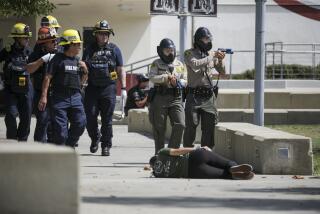Ex-deputy’s murder charge is first in California under new use-of-force law

- Share via
SAN DIEGO — When San Diego County Dist. Atty. Summer Stephan announced last month that former sheriff’s Deputy Aaron Russell would face a murder charge in the fatal shooting of a man in May, it wasn’t just the first time a law enforcement officer in the county had faced such a charge.
The Russell case also marks the first time a law enforcement officer has been charged in California under a new state law, which went into effect Jan.1, changing the legal standard that regulates when police can use deadly force.
As a result, Russell’s case — if it goes to trial — could be the first test of that new law, AB 392, that was authored by San Diego Assemblymember Shirley Weber.
Among other things, the law changes the standard for when police can use deadly force from when “reasonable” to when “necessary” to prevent imminent and serious injury or death.
Yet legal experts say that what exactly that change means — and how lawyers will argue about it, judges interpret it and juries apply it — still has to be determined, likely in courts. Already one police department is being sued by the American Civil Liberties Union over how that department is training officers on what the new law means.
Nicholas Bils was killed May 1 after he slipped out of a pair of handcuffs and escaped from a state park ranger’s car just outside the downtown San Diego Central Jail. The 36-year-old had been arrested earlier that day for allegedly threatening a ranger with a golf club at Old Town San Diego State Historic Park.
Prosecutors say Russell, a 23-year-old deputy assigned to work in the jail, fired five shots at Bils, who was unarmed and running away from Russell, a second deputy and two park rangers. In deciding to charge Russell, prosecutors noted that no other law enforcement officer had pulled a gun.
Stephan said the unprecedented decision to charge Russell with murder was a result of analyzing his actions under the new legal standard of AB 392.
Russell has pleaded not guilty to second-degree murder. His attorney, Richard Pinckard, declined to comment this week but said previously that “significant defenses” would be raised as the case moved forward.
In an earlier statement after Russell’s July 14 arraignment, Pinckard pointed to a 1998 U.S. Supreme Court case known as Graham vs. Connor, which largely established the legal concept that use of force by police should be judged under the “reasonable officer on the scene” standard.
Ed Obayashi, a former police officer and deputy public defender in San Diego, said Pinckard was correct. Obayashi is now a nationally recognized use-of-force expert and advises numerous law enforcement agencies in the state.
“The bottom line, whether he is convicted or not, is still going to hinge on whether his actions or the shooting was reasonable under the circumstances,” he said. “And reasonable means necessary — legally they mean the same thing.”
Not all agree, however. Adrienna Wong, a lawyer with the ACLU of Southern California, said that it was clear that the law did change the standard for using force.
“Overall, the standard has changed from reasonable to necessary,” she said.
She pointed to analyses by the state legislative analyst and the statements made when Gov. Gavin Newsom signed the bill into law as evidence that the Legislature intended to make a more exacting standard for police using force.
Even given that, Wong said, the ACLU has found not all agencies agree.
In August the group filed a lawsuit against the Pomona Police Department, contending that the department is undermining the law by continuing to instruct and train its officers that AB 392 “did not change the legal standard” for police officers’ use of force, according to the suit.
The lawsuit says the Peace Officers Research Assn. of California had fought a rear-guard action against the legislation and told departments like Pomona’s that the law had not substantively changed.
The suit seeks an injunction that among other things would ban the department from using any resources, including money or employee time, to tell or train officers that the new law does not establish a “necessary” standard for use of deadly force.
Brian Marvel, the president of the research association, which is discussed in the suit but is not a named defendant, said in an email that the bill did, indeed, “change the law.”
Marvel, however, echoed Obayashi’s position by noting “necessity is determined based on an objectively reasonable officer.”
It is a fine distinction but one that may have to be hashed out and settled in court — perhaps in Russell’s case.
“It all depends on whether a judge or jury takes that word that is there now and says it is meant to heighten the burden on an officer,” said Robert Weisberg, a law professor and faculty co-director of the Criminal Justice Center at Stanford University.
Eugene Iredale, a prominent San Diego civil rights attorney who is representing the Bils family, said that the new law was clear that the standard for using deadly force was raised and that that should not be an issue.
Both he and Weisberg pointed to another element of the law they said strengthened the prosecution’s case against Russell. They noted that the law tightened the circumstances for when police could shoot at someone who was escaping.
Previously, state law said deadly force could be used only when trying to apprehend a fleeing felon. The law now says deadly force can be used in that situation only to stop a person suspected of committing a felony that “threatened or resulted in death or serious bodily injury, if the officer reasonably believes that the person will cause death or serious bodily injury to another unless immediately apprehended.”
That change made state law track a second U.S. Supreme Court decision, the 1985 ruling in the case known as Tennessee vs. Garner, in which the court ruled police could only use deadly force on someone fleeing if there was the threat of serious injury or death. But the court did not require states to adopt that standard, Weisberg said, and for years California did not.
Weber’s bill now brings state criminal law into accord with that ruling, Weisberg said. With that in the law, Russell would also have to show he believed the unarmed Bils was “exhibiting a clear likelihood of violence against human beings,” he said.
Iredale praised Weber’s bill but also said that, based on the case outlined so far, “with or without that statute, this case would have been charged.”
In an affidavit for the arrest warrant for Russell, a DA investigator wrote that Russell and a second deputy were across the street from the jail when they saw one of Bils’ arms reaching out the window of a California state park ranger’s Ford Crown Victoria as it approached the vehicle gate to the jail.
Bils was able to get out of the vehicle and began running up Front Street. Russell, holding his lunch tote, a water bottle in one hand and a COVID-19 mask in the other, chased him as he ran toward B Street. He transferred the mask to his left hand with the other items and unholstered his weapon with his right.
He was 15 to 20 feet away from Bils when he opened fire, the affidavit said. An autopsy report said Bils was shot at least four times.
Moran writes for the San Diego Union-Tribune.
More to Read
Sign up for Essential California
The most important California stories and recommendations in your inbox every morning.
You may occasionally receive promotional content from the Los Angeles Times.










